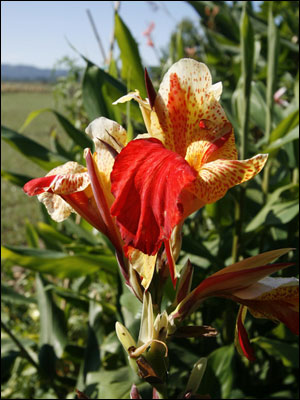Cannas
 Cannas are tropical bulbs that can add lush color and texture to any Florida garden, thanks to their beautiful flowers and interesting leaves.
Cannas are tropical bulbs that can add lush color and texture to any Florida garden, thanks to their beautiful flowers and interesting leaves.
Wild types are water loving and thrive in boggy areas and ponds, while popular commercial cultivars like 'Black Knight', 'Pretoria', 'Tropicanna'™, 'Wyoming', and others will grow in most gardens if given adequate care.
Gardeners looking for specific cultivars should know that some are sold under multiple names. For example, 'Tropicanna' is also known as 'Durban' and 'Phaison', while 'Pretoria' is also known as 'Bengal Tiger', 'Malawiensis Variegata', and 'Striata'.
Characteristics
Cannas are heat-loving perennials so they are great performers in Southeastern gardens. With proper care, plants can grow anywhere from a few feet in height ('Lucifer' and 'Picasso') to over fifteen feet tall ('Musifolia').
The flowers come in shades of pink, yellow, orange, and red and will reappear throughout the season if the old flowers are removed (some cultivars are self-cleaning, making dead-heading unnecessary).
The plants are interesting even when they're not in bloom, thanks to their banana-shaped leaves that come in green, purple, and variegated forms.
Planting and Care
Cannas can be purchased either as rhizomes or as potted plants. Rhizomes should be planted two weeks before the last spring frost, while potted plants can be planted anytime during the warmer months.
Cannas grow best in sites that have rich, organic soil and full sun, though they will grow in most soils if they are well watered and fertilized, either with monthly applications of a balanced fertilizer or with fewer applications of a controlled-release fertilizer.
Gardeners should keep their eyes open for signs of the canna leaf roller, which can be a major pest.
For more information on cannas, contact your county Extension office.

